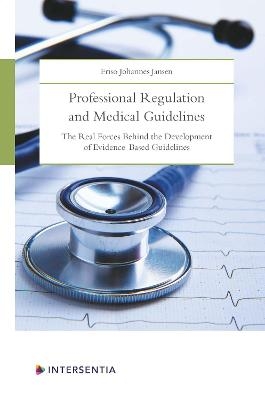
Professional Regulation and Medical Guidelines
The Real Forces Behind the Development of Evidence-Based Guidelines
Seiten
2020
Intersentia Ltd (Verlag)
978-1-78068-819-0 (ISBN)
Intersentia Ltd (Verlag)
978-1-78068-819-0 (ISBN)
This book addresses the fundamental question of the creation of medical guidelines in healthcare systems, critiques the current state of 'evidence-based' guideline-making in England and the Netherlands, and demonstrates how the development of guidelines involves a series of subjective choices driven by economic, cultural, institutional and political forces.
Evidence-based medical guidelines are an inescapable element of current medical practice, but how are they developed? This book interrogates what causes these differences and similarities between guidelines and uncovers the mechanisms behind the development of medical practice guidelines. Four case studies, on lower back pain and on type 2 diabetes in England and the Netherlands, are used to provide a detailed empirical account of the development of medical guidelines. Interviews with guideline developers are combined with a detailed analysis of guideline documents. Theories from science and technology studies, institutional literature, group decision-making, and professional self-regulation are used to demonstrate how the development of guidelines involves a series of subjective choices driven by economic, cultural, institutional and political frames. Medical evidence plays a more limited and nuanced role in guideline construction than might be expected. Professional Regulation and Medical Guidelines sheds light on the power of experts and institutions to shape the governance of healthcare, and argues for greater transparency of the processes by which experts decide on the gold standard of care. The book will be of interest to guideline developers, medical professionals, policy makers, sociologists and lawyers who are interested in the interaction of science and law. It provides rich empirical data into the often opaque and little understood world of rule-making by experts.
Evidence-based medical guidelines are an inescapable element of current medical practice, but how are they developed? This book interrogates what causes these differences and similarities between guidelines and uncovers the mechanisms behind the development of medical practice guidelines. Four case studies, on lower back pain and on type 2 diabetes in England and the Netherlands, are used to provide a detailed empirical account of the development of medical guidelines. Interviews with guideline developers are combined with a detailed analysis of guideline documents. Theories from science and technology studies, institutional literature, group decision-making, and professional self-regulation are used to demonstrate how the development of guidelines involves a series of subjective choices driven by economic, cultural, institutional and political frames. Medical evidence plays a more limited and nuanced role in guideline construction than might be expected. Professional Regulation and Medical Guidelines sheds light on the power of experts and institutions to shape the governance of healthcare, and argues for greater transparency of the processes by which experts decide on the gold standard of care. The book will be of interest to guideline developers, medical professionals, policy makers, sociologists and lawyers who are interested in the interaction of science and law. It provides rich empirical data into the often opaque and little understood world of rule-making by experts.
Dr Friso Jansen is Senior Law Lecturer at Birmingham City University and holds a DPhil in Socio-Legal Studies from the University of Oxford. He is an experienced academic with a particular focus on the interaction of science and law.
Table of contents and preliminary pages (p. 0) Chapter 1. Introduction (p. 1) Chapter 2. Understanding Guidelines in their Academic Context (p. 11) Chapter 3. Guidelines in the Netherlands and England (p. 55) Chapter 4. Lower Back Pain: guidelines in England and the Netherlands (p. 81) Chapter 5. Type II Diabetes: Guidelines in England and the Netherlands (p. 131) Chapter 6. Guidelines in a Comparative Sense (p. 183) Chapter 7. Conclusion (p. 215) Bibliography (p. 229)
| Erscheinungsdatum | 11.05.2024 |
|---|---|
| Verlagsort | Cambridge |
| Sprache | englisch |
| Maße | 152 x 229 mm |
| Gewicht | 400 g |
| Themenwelt | Geschichte ► Teilgebiete der Geschichte ► Militärgeschichte |
| Recht / Steuern ► EU / Internationales Recht | |
| Recht / Steuern ► Privatrecht / Bürgerliches Recht ► Medizinrecht | |
| Recht / Steuern ► Rechtsgeschichte | |
| Recht / Steuern ► Strafrecht | |
| ISBN-10 | 1-78068-819-9 / 1780688199 |
| ISBN-13 | 978-1-78068-819-0 / 9781780688190 |
| Zustand | Neuware |
| Haben Sie eine Frage zum Produkt? |
Mehr entdecken
aus dem Bereich
aus dem Bereich
neueste Manipulationstechniken als Waffengattung der NATO
Buch | Softcover (2023)
Westend (Verlag)
24,00 €
Deutschlands Schwäche in der Zeitenwende
Buch | Softcover (2023)
C.H.Beck (Verlag)
18,00 €


